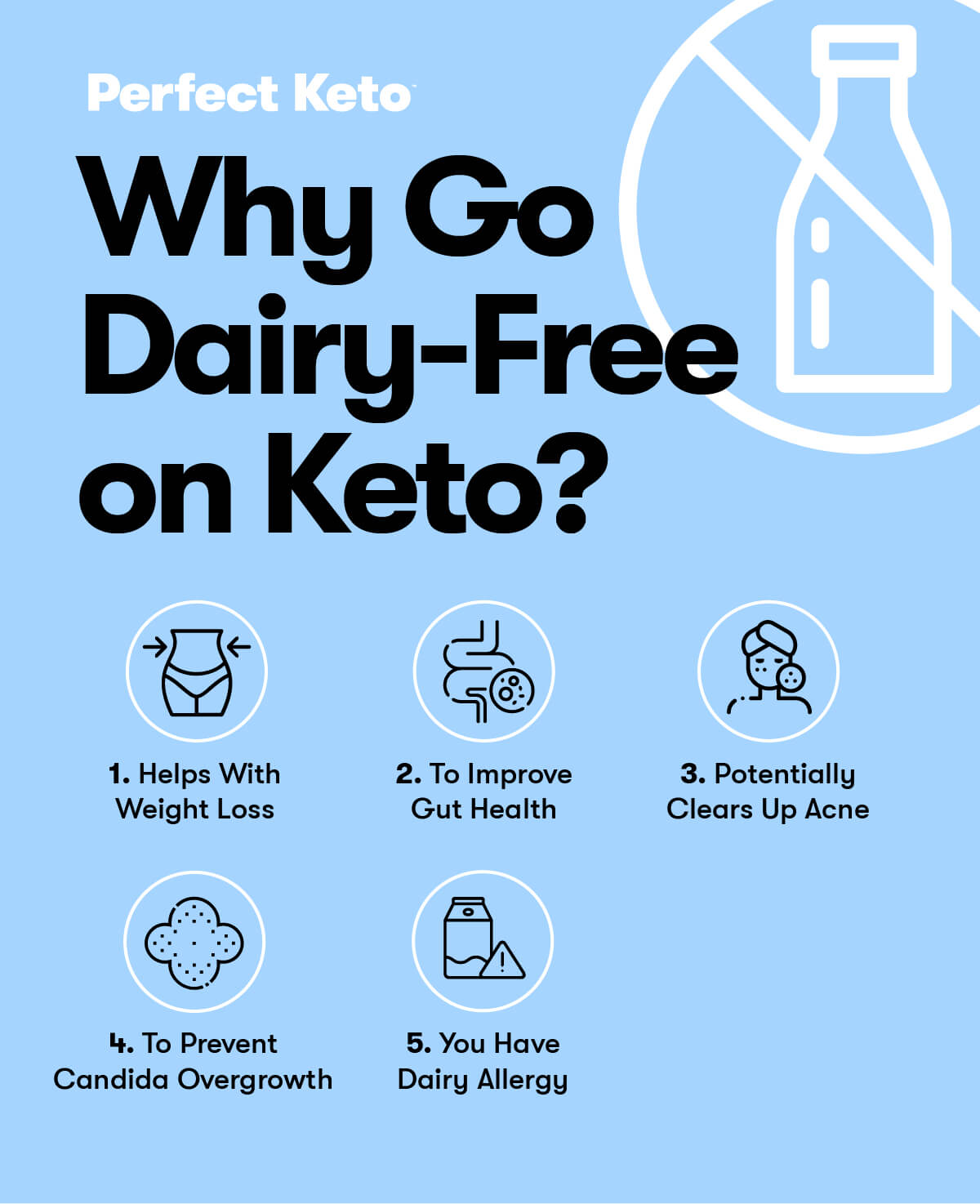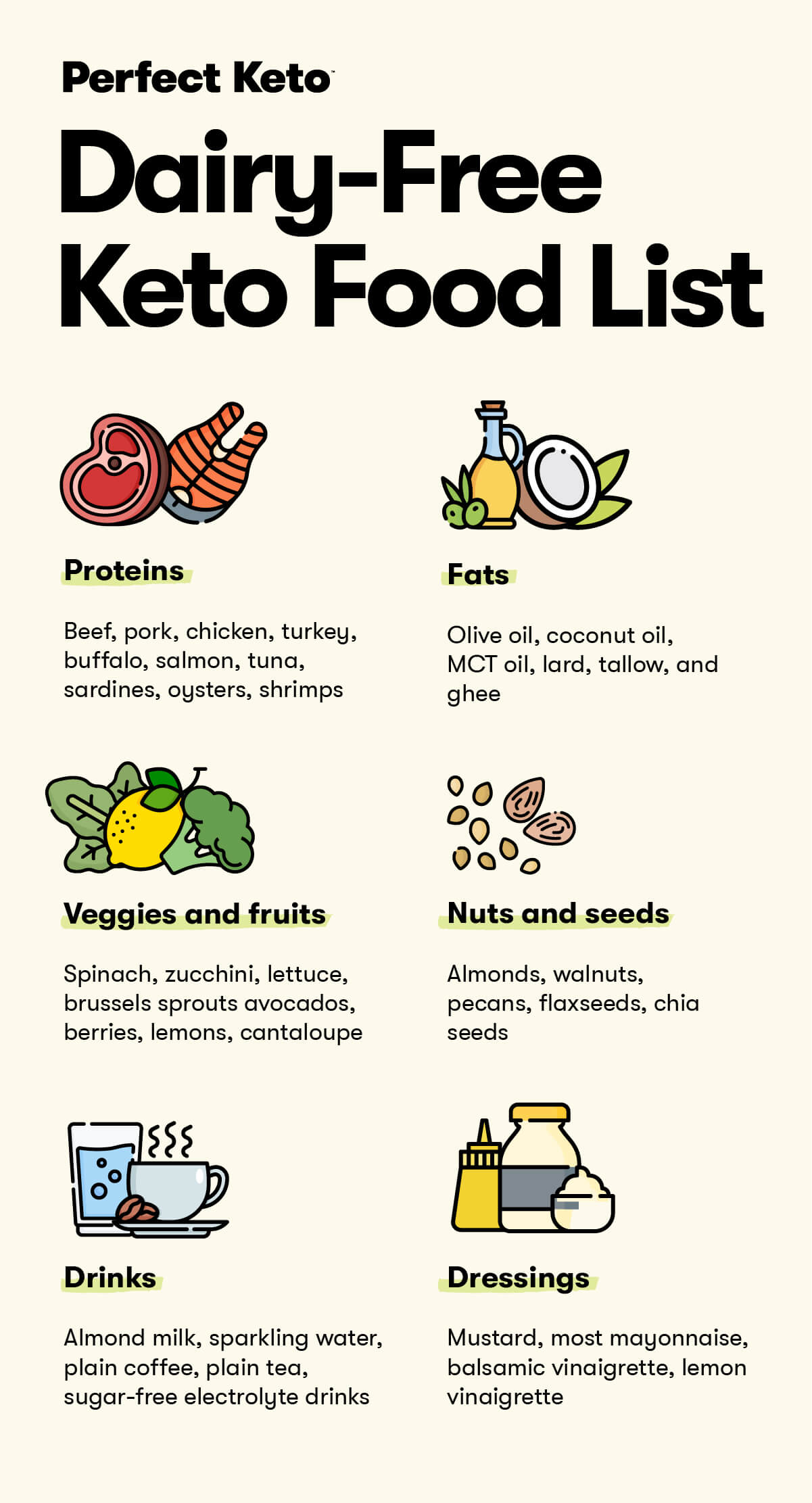Dairy products such as cow’s milk, cheese, butter, and yogurt are good sources of fat and protein on a keto diet. They also provide important vitamins and minerals like calcium, phosphorus, vitamin D, and vitamin K (*).
But for some people, consuming dairy (especially in large amounts) can cause skin and digestive problems, and prevent them from losing weight on a keto diet.
This article explains whether you can do keto without dairy — and if so — the reasons it’s a good idea for weight loss, gut health, reduced acne occurrence, and more. Additionally, we’ll show you how to follow keto dairy-free, plus a food list and dairy-free meals.
Can You Do Keto Without Dairy?
Eating dairy is a great way to obtain fat, but it’s also completely fine for keto dieters to skip dairy. Given the negative effects of dairy on some people who are sensitive or less tolerant to it, a dairy-free keto diet may be the best way to go.
If you’ve already avoided dairy before starting a keto diet, then continue that approach on keto so you can keep on experiencing its benefits.
But in case you’re not sure how dairy affects you, try checking your blood glucose and ketone levels in response to dairy foods. Alternatively, you can keep a food journal to track how you feel, including unwanted symptoms, after eating dairy.
You may also get a lactose tolerance test (to measure lactose intolerance), a skin prick test, or a blood test to measure certain antibodies in your blood (*).
Why Go Dairy-Free on Keto?
The problem with dairy is that not everyone handles it the same. For example, certain people struggle with weight loss and get acne breakouts when they eat dairy. Here are five benefits of a non-dairy keto approach:

1. Helps With Weight Loss
Cutting dairy from your diet could lead to weight loss. That’s because dairy, which contains both fat and carbohydrates, can quickly increase your calorie intake. Not to mention, dairy offers a delicious treat and is easy to overconsume — unless you’re diligently tracking your macros and calories.
A lot of keto dieters love adding dairy products like cheese, butter, and milk to their meals and beverages, and do so in excessive amounts. If you can tolerate dairy well, but you’ve reached a weight loss plateau, consider cutting back for a few weeks and see if your weight loss improves.
2. To Improve Gut Health
Some individuals are lactose intolerant, meaning that they cannot digest lactose, which is a type of sugar found in dairy.
If you’re lactose intolerant, you’ll experience digestive problems 30 minutes to 2 hours after ingesting milk or any dairy product. These digestive issues include bloating, diarrhea, flatulence, nausea, abdominal pain, and flatulence (*).
Lactose intolerance may cause headaches, muscle pain, joint pain, and an inability to concentrate — in addition to the gut symptoms mentioned above (*).
Important: Keep in mind that digestive issues may also be caused by disorders like irritable bowel syndrome (IBS), and not just dairy.
3. Potentially Clears Up Acne
The keto diet can give you healthier skin by reducing refined carbs and sugar, which create an inflammatory response and irritate your skin. Additionally, focusing on dairy-free fats on keto could improve acne or prevent flare-ups (*).
A systematic review and meta-analysis showed that consuming any type of dairy, including milk (full-fat, whole, low-fat) and yogurt — regardless of the amount or frequency — is linked to higher chances of acne (*).
In that case, experimenting with a dairy-free keto diet may be worth a try if you think dairy is aggravating your acne.
4. To Prevent Candida Overgrowth
Candida (a type of yeast) lives in the human body and it’s normally harmless. However, certain conditions can cause it to grow uncontrollably, which then becomes problematic (*).
Health issues that result from candida overgrowth include recurring urinary tract infections, tiredness and fatigue, and sinus infections (*, *, *).
If you’re at risk for candida overgrowth, one of the things you can do is exclude dairy from your diet — on top of avoiding refined carbohydrates and added sugars. Lactose (in high amounts) in dairy can promote candida growth, which is why it’s probably best to cut it out (*).
5. You Have Dairy Allergy
Being allergic to milk or dairy means that your immune system considers dairy products as invaders (*).
As a result, you’re likely to suffer digestive problems and other symptoms like itching, hives, vomiting, and even anaphylaxis (a severe allergic reaction) after eating or drinking dairy.
Since milk contains calcium, you need to make sure to look for other sources of calcium in your keto diet (along with other nutrients found in milk).
How to Follow a Dairy-Free Keto Diet
If you’re considering making the switch from a standard keto diet to a dairy-free keto diet, below are tips that will help.
- Make a habit of reading food labels – Look for statements like “may contain milk” or “made in a facility with milk.” Also, note that dairy tends to appear under different names like casein, curds, lactose, hydrolysates, whey, and yogurt powder.
- Go for ghee if you’re lactose-intolerant – While not technically dairy-free, since ghee is made from butter, it’s a good choice for those who need to avoid lactose. You may be able to tolerate ghee better than butter. It can be used the same way you would use butter, such as frying eggs and veggies or making delicious keto coffee.
- Make nutritious swaps to avoid nutrient deficiencies – When replacing dairy, pack your keto diet with alternatives (that are excellent sources of calcium, phosphorus, vitamin D, and vitamin K). Examples are sardines (with bones), chicken, turkey, liver, and vegan options like almonds, green leafy veggies, and mushrooms.
Dairy-Free Keto Food List
Just because you’ve decided to do keto without dairy, doesn’t mean you’ll have limited options. Feel free to use this list of foods for your next visit to the grocery.
- Proteins: beef, pork, chicken, turkey, buffalo, salmon, tuna, sardines, oysters, shrimps
- Fats: olive oil, coconut oil, MCT oil, lard, tallow, and ghee
- Veggies and fruits: spinach, zucchini, lettuce, brussels sprouts avocados, berries, lemons, cantaloupe
- Nuts and seeds: almonds, walnuts, pecans, flaxseeds, chia seeds
- Drinks: almond milk, sparkling water, plain coffee, plain tea, sugar-free electrolyte drinks
- Dressings: mustard, most mayonnaise, balsamic vinaigrette, lemon vinaigrette
A lot of processed keto foods are hidden sources of dairy. So, in addition to reading food labels, we recommend cooking most of your meals at home.

Foods and Products to Avoid on a Non-Dairy Keto Diet
Here’s a list of foods you can’t eat on a dairy-free keto meal plan:
- Butter
- Cheese
- Milk
- Cream and sour cream
- Yogurt
- Salad dressings containing milk
- Some deli meats (dairy is often used as an emulsifier)
- Keto protein bars containing whey
- Vegan meat products containing whey or casein
- Keto bread and other baked goods with milk
Sample Dairy-Free Keto Meal Plan
Try any one of these dishes if you’re trying to avoid dairy. Whether you’re a vegetarian or love both meat and veggies, you’ll enjoy these options.
Day 1
- Breakfast: keto pancakes made with coconut flour, eggs, and sugar-free syrup
- Lunch: garlic and herb pork loin roast
- Dinner: ground beef or ground turkey with broccoli
Day 2
- Breakfast: scrambled eggs and uncured bacon
- Lunch: asparagus, zucchini, lettuce leaves, and walnuts salad
- Dinner: Asian-style chicken wings (marinade: tamari soy sauce, tomato paste, garlic powder, olive oil)
Day 3
- Breakfast: chia seed pudding (using almond milk)
- Lunch: smoked salmon and roasted vegetables
- Dinner: lemon garlic shrimp pasta (using shirataki noodles)
Day 4
- Breakfast: tuna stuffed avocados
- Lunch: cauliflower hash browns (made with grated cauliflower, eggs, onion, and salt)
- Dinner: flank steak with mushrooms
Day 5
- Breakfast: fried bacon and cabbage
- Lunch: tuna lettuce wraps
- Dinner: keto ramen (made with shirataki noodles, chicken broth, chicken breast, bok choy, and spices)
Frequently Asked Questions
Here are answers to common questions on doing keto without dairy:
Does dairy cause weight gain on keto?
When consumed in excessive amounts, yes, dairy can cause you to gain weight. Keep in mind that dairy products are high in calories and taste good, so it’s easy to overconsume them if you’re not careful.
How can I get enough fat on keto without dairy?
To increase your fat intake the dairy-free way, focus on eating a variety of meats, seafood, low-carb veggies and fruits, nuts, and seeds. When it comes to oils for cooking, you can use healthy plant-based oils like avocado oil, coconut oil, and olive oil.
Is keto still beneficial without dairy fats?
Yes. The keto diet doesn’t have to include fats from dairy in order to promote better health, especially for those who are sensitive to dairy. However, you need to find alternatives that can provide calcium and other essential nutrients.
Does dairy affect ketosis?
Dairy can knock you out of ketosis if you don’t watch your carbs. That’s because some dairy products have a higher carb content per serving than others — for example, full-cream milk.
Yes, A Dairy-Free Keto Lifestyle is Possible
Whether you’re sensitive to dairy or not, there are many health and anti-inflammatory benefits of doing keto without dairy. This is helpful if you think that dairy is causing your weight loss plateau and you want to optimize other areas of your health.
Anyone will be able to enjoy dairy-free living by reading food labels (watching out for dairy ingredients), making sure they get nutrients from other foods, and using dairy-free alternatives for their recipes.
Speaking of recipes, we’d love for you to try Perfect Keto’s tasty dairy-free options for breakfast, lunch, dinner, and dessert time.